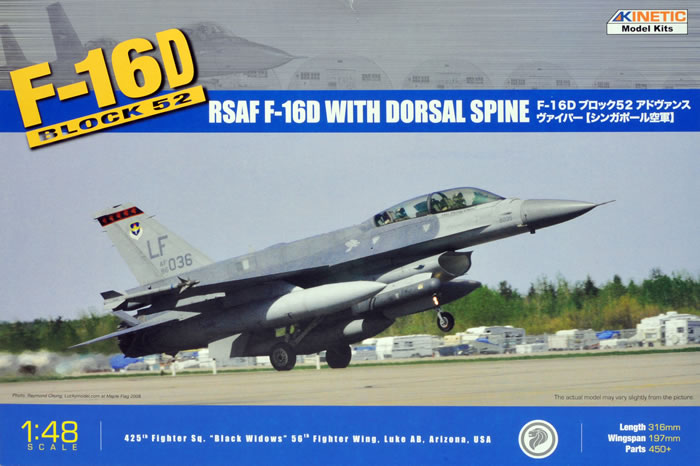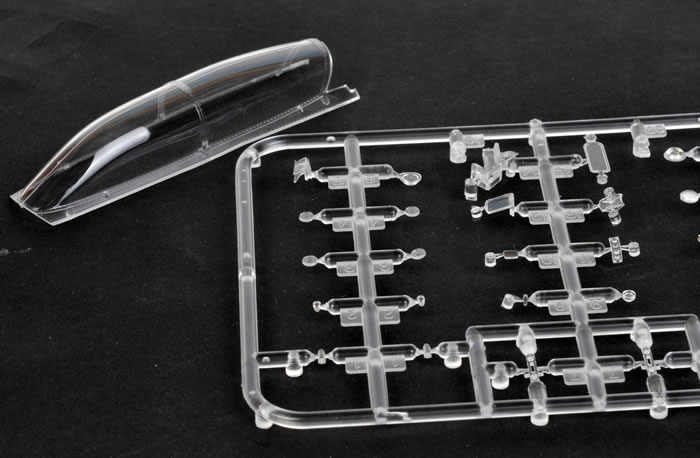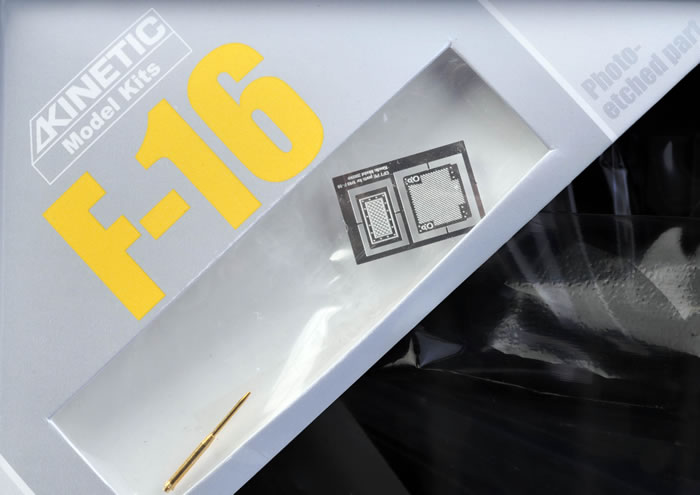Lockheed Martin F-16D Block 52
RSAF F-16D / Dorsal Spine

Kinetic, 1/48 scale
S u m m a r y |
| Item No. |
Kinetic Model Kits # K48007 - Lockheed Martin F-16D Block 52 – RSAF F-16D with Dorsal Spine |
| Contents and Media: |
Approximately 450 parts in grey and clear-cloured plastic; photo-etched CFT; turned brass pitot tube; markings for one aircraft. |
| Scale |
1/48 |
| Price: |
USD$29.98
plus shipping available online from Lucky Model |
| Review Type: |
FirstLook |
| Advantages: |
Complete detail; comprehensive weapons fit; good surface detail; excellent cockpit, wheel well and engine nozzle detail; nicely printed decal sheet; clear transparencies; concise instructions |
| Disadvantages: |
Clear transparency needs a coat of clear smoke to replicate tint. |
| Recommendation: |
The Kinetic RSAF F-16D will deliver a very well detailed and reasonably accurate model straight from the box with no need for expensive aftermarket sets to detail or convert to this version of the F-16. |
Reviewed
by Mick Evans

HyperScale is proudly supported by Squadron.com
Kinetic Model Kits has released two new two-seater F-16 variants. Tonight we will examine kit number K48007, the 1/48 scale Lockheed Martin F-16D Block 52 – RSAF F-16D with Dorsal Spine.
The basic sprues of this kit are identical to the previous releases of the Kinetic F-16D twin seaters. The new sprues cover the specific antenna fit and ECM gear that are fitted to the Singapore F-16s. This kit also has the exhaust nozzle for the Pratt & Whitney the F100-PW-229 engine and the small mouth intake included.
It appears that this model represents the Block 52 version that was purchased by the RSAF in the1990’s and is assigned to the training squadron at Luke AFB in the US as well as two squadrons in Singapore. At one poin,t a second training squadron operated these same aircraft at Cannon AFB in the US. These aircraft have the dorsal spine with the extended Para brake fairing that is found on this kit. These aircraft are not configured to use the CFT’s.*
The make up of the RSAF kit is at least 90% common with the Sufa kit that I reviewed earlier so I will not repeat these parts in this review.
Now that I have almost finished building the Sufa kit I can comment on comparisons with the Hasegawa F-16D that I converted to a Brakeet, and the Tamiya F-16 that I built as a Barak. Criticisms of the Kinetic kit have focused on the nose droop, lower fin parachute/ECM fairing and the panel lines.
Lining up all three completed kit, there is no apparent difference in the nose droop. I think criticism of this area came about due to the join line in the Kinetic kit being a different profile.

Under a coat of paint, the panel lines look very similar to the Tamiya kit, Tamiya’s being slightly sharper, although there is some difference in the location of some panels. I did not have accurate enough drawings to comment but the difference in placement of the panels in the two kits is minor. On comparing the Kinetic Barak to the Tamiya kit and many photos, it can be seen that the ECM/para faring at the base of the fin on the Kinetic kit is too wide, but this can be easily fixed with careful sanding gradually to reduce the fairing from where the leading edge of the fin joins back to the rear.

Sitting the two Baraks (Tamiya and Kinetic) side by side it is difficult to pick the difference. Although Tamiya’s is a bit finer in surface features, Kinetic has better wheel well detail. Much of a muchness really. The big difference is all of the options and the huge detail set in the Kinetic kit. The downside is the extra work required to assemble the Kinetic kit. For some reason this kit had reverse knock out pins that are actually protrusions. These are a bonus on external visible surfaces as you can trim them off and sand without losing surface detail unlike the usual depression on other kits that has to be filled and sanded. But they are present on the inside surface of every curved surface such as fuselage, fuel tanks, bombs etc, and they must be removed before assemble can begin.

The decals are nicely printed with good colour saturation and crisp detail. A complete sheet of weapons markings is also provided.
Markings are provided for one aircraft, serial number 96-5035.
The instruction sheet gives a good level of breakdown and clear instruction while the painting and decal instruction sheet is in colour and provides excellent colour scheme and decal placement detail.
There will always be criticism of minor inaccuracies but I am yet to see a faultless model.
I am happy to build Kinetic's 1/48 scale F-16D, and will be proud to display it.
With all of the weapons provisions supplied, I think that it provides the best value for money for any late model F-16 kit.
Thanks to Lucky Model for the samples
Review Text Copyright © 2009 by Mick Evan
* additional information about RSAF F-16Ds by Joe Zerbe
Images Copyright © 2009 by
Brett Green
Page Created 11 June, 2009
Last updated
12 June, 2009
Back to HyperScale Main Page
Back to Reviews Page

|
Home
| What's New |
Features |
Gallery |
Reviews |
Reference |
Forum |
Search